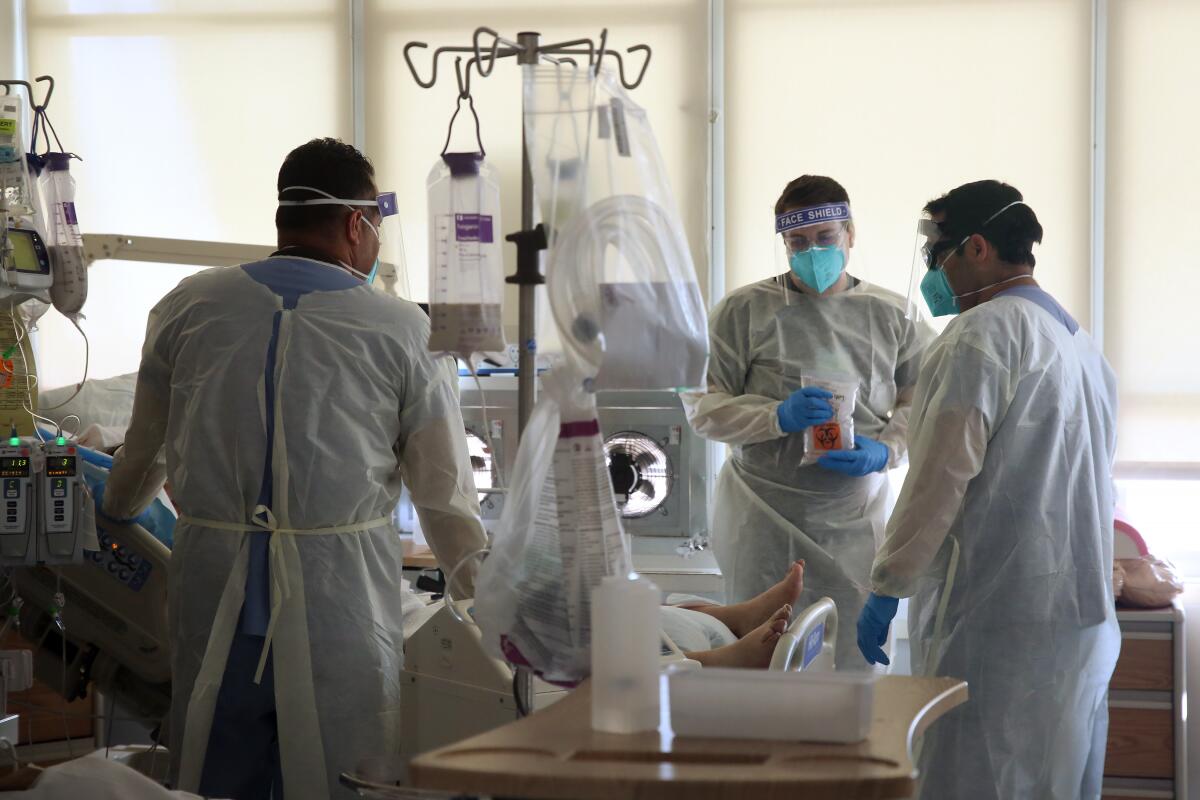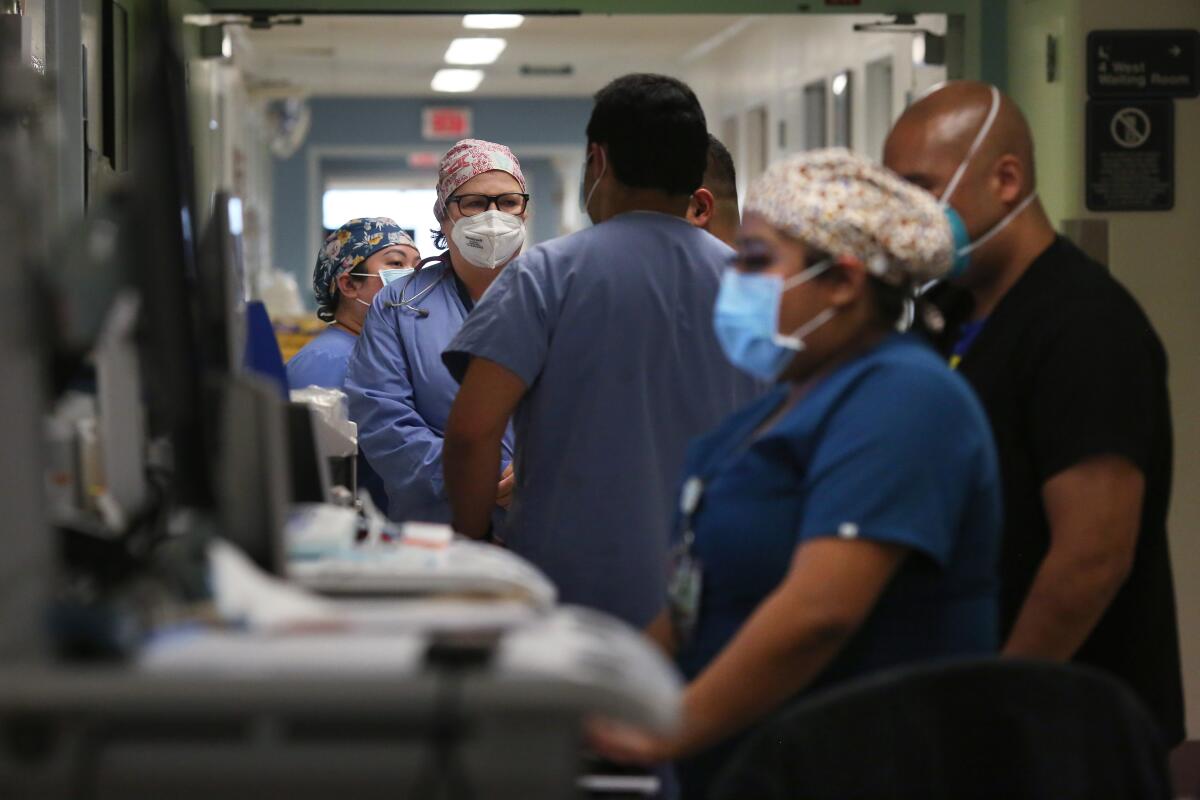Battered by COVID surge, hospitals are admitting patients faster than they can discharge them

- Share via
The patient needed a ventilator or she would die. The hospital wanted to discharge her, but there was no place she could go.
As the surge of coronavirus infections created a terrifying shortage of hospital beds across Southern California, discharge planner Erika Gomez faced a dilemma. She needed to move the woman — a neurology patient — as safely as possible, while also freeing up a critical bed at Rancho Los Amigos National Rehabilitation Center.
Over the next two weeks, Gomez reached out to 126 subacute care and congregative living health facilities in Los Angeles County, searching for a bed and a ventilator. Though some considered caring for the woman, they all ultimately said no. Her insurance wouldn’t pay enough.
Finally, a residential home with which Gomez had a good relationship agreed to help. It would take the woman in and lend her a ventilator.
Days earlier, Rancho Los Amigos — which is taking in patients from the other three county public hospitals to help lighten their load — had nearly reached its capacity. Even with discharges, it was like trying to save the Titanic from sinking with a teacup.
The work of discharge planners has never been more critical than in this moment, as they try to free up beds in dangerously full hospitals confronting a deluge of COVID-19 patients.
For some patients and their families it can feel like an eviction. But for the people on the other side of the battle against an unrelenting pandemic, it’s about saving lives and keeping the precarious Jenga tower of a healthcare system from crashing down.
“We’re working as fast as we can,” Gomez said. “Administration is asking, ‘Well what are your efforts? What are you doing now to discharge patients sooner rather than later?’”

Every day is like a jigsaw puzzle, with discharge planners trying to figure out where patients fit. There are nursing homes suffering staffing shortages or that are in lockdown. Patients who refuse to transfer or whose families are worried they won’t get the care they need elsewhere. Health plans that won’t approve moving a patient to an agency that they don’t contract with.
“If there is another place for them to go we need to let that patient go to that other bed … because there’s somebody else who’s dying right now and they need a bed,” said Suzette Shields, a clinical social work supervisor at Harbor-UCLA Medical Center.
In L.A. County, hospitalizations have stabilized at a high number, hovering between 7,900 and 8,100 from Monday through Thursday. But officials have warned that the level of hospitalizations is unsustainable, leading to a shortage of available ambulances and forcing patients to wait hours for beds to open.
The county’s four public hospitals, which include Rancho Los Amigos, as well as other hospitals across Southern California, may soon ration care because they are so short on resources.
At a news conference Friday, California Hospital Assn. Chief Executive Carmela Coyle said that hospitals are struggling to discharge patients to skilled nursing facilities, home health care and other settings outside the hospitals.
She cited some counties that passed bans prohibiting skilled nursing facilities from accepting hospital patients because of concern about COVID-19’s spread. Some of those bans still exist in many places, she said.
“We really need help. We need a release valve,” she said. “We have ambulances continuing to flow into hospitals, dropping patients off in acute care need. And yet, we have challenges in discharging patients to other parts of the healthcare system when they are no longer in need of that acute care, and it is creating a bottleneck.”

Dr. Christina Ghaly, the L.A. County director of health services, said Tuesday that within the Department of Health Services about 10% of inpatients no longer needed an acute level of hospital care.
Charmaine Dorsey, director of the department’s Patient and Social Support Services, said there are close to 100 patients waiting to be discharged in the county’s four public hospitals. But it’s been a frustrating task to move them and free up badly needed beds.
Health plans were asked to help reduce administrative barriers, Dorsey said, “yet we are still being denied authorizations and experience increased delays in obtaining authorizations.”
“We’re in a crisis now where if we find a place, we need the health plan to say, ‘Go ahead and send the patient, you need to get them out of your bed and put them in the right level of care,’” Dorsey said. “Health plans, help us. Don’t deny.”
Last week at Rancho Los Amigos, Gomez’s patient caseload had doubled into the 20s.
She spent a day working on a placement for a woman who had been in the hospital for two weeks, only for her family to turn down the transfer. (State law prohibits the movement of a patient unless the person agrees to the placement.)
The patient’s family members asked that she be moved to a specific facility they had in mind — which was on lockdown because of COVID-19. They later filed an appeal through Medicare. After the appeal was denied Wednesday, Gomez stayed late to speak with the family, who eventually agreed to the discharge for that evening.
Even before the pandemic, discharge planners across the state faced challenges finding placement for patients who were uninsured, homeless or dealing with comorbidities of health — to name a few.
The workers spend days making referrals and calling residential homes, skilled nursing facilities and nursing homes to try to find the right place.
As of Thursday, the most recent day for which complete data are available, there were 21,855 coronavirus-positive patients hospitalized in California, with 4,812 in intensive care.
Coyle called on county and state governments to help hospitals with transitioning patients out of hospitals, especially in the hardest-hit areas of the San Joaquin Valley and Southern California. She said this will be particularly important over the next 10 days, when she anticipates the surge to reach its worst moment.
In Orange County, Angelica Rojas, whose husband had spent about a month in the intensive care unit at Providence St. Jude Medical Center, worried when she was told in December that her husband might be transferred.
“They told me there’s so many patients, that they’re trying to free up beds,” Rojas said. But she worried that her husband would get sick again and possibly regress. “My husband is still not out of the woods.”
She said she was relieved to learn that her husband would be moving to Providence St. Jude’s Inpatient Rehabilitation unit in the next few days, instead of a different hospital.
Speaking generally about patient cases, Roslyn Ausina, director of case management at Providence St. Jude, said there is often a lot of discussion with families regarding potential transfers outside the hospital.
With a higher volume of patients in the emergency room, there’s always someone ready to go to the next bed.
“During this pandemic, we understand the need to create critical surge capacity. At the same time we must address discharge difficulties, always ensuring the right level of care at the right time and place,” Ausina said. “The No. 1 priority is that patients go to a safe place to heal and recover.”
It’s a delicate balance and one that Maritza Sandoval, a discharge planner at Harbor-UCLA, is well acquainted with.
In a recent case, members of a family did not want their loved one transferred from the hospital and threatened to call their attorney.
The children wanted their mother in a specific rehabilitation hospital, but therapists at the hospital didn’t feel she was eligible for that care.
On a call with the woman’s son, Sandoval laid it out on the table.
“I’m sorry; I’m being honest with you, we need the beds,” she said. “We have many people waiting in our emergency room just for a bed who are really sick. Your mother is no longer sick … we should be thankful for that.”
Discharging his mother meant someone who needed to get out of the emergency room could then take her bed.
Thankfully, she said, the woman’s son understood.
“Sometimes you just have to empathize with them and say, ‘Look, I understand where you’re coming from, I know you’re afraid,’” Sandoval said. “It’s constantly working with families and trying to think of other alternatives that they’re comfortable with and hope that they work.”
Sandoval has had cases in which a patient has the coronavirus and families are afraid for them to come home because they feel they can’t care for them.
One woman, who was coronavirus-positive and ready to be discharged home with oxygen, told the staff she was too anxious to leave. Sandoval connected her with a clinical social worker who calmed her and got her discharged the next day.
In the emergency room, discharge planners described seeing beds by the ambulance entrance of patients just waiting to be seen. Several units in the hospital have been converted to take care of patients.
“What if that’s someone’s loved one who just had a heart attack and that has nothing to do with COVID, but now they can’t come into the emergency room because we have no bed?” Shields asked.
On Dec. 7, 51 COVID-19 patients were at Harbor-UCLA, with 18 in the ICU. On Thursday, that number stood at 164, with 52 in the ICU. (By Friday, the number of patients with the coronavirus had risen to 171.)
Discharge planner Yesica Lopez crossed her fingers Thursday that she’d be able to discharge at least one patient so she could free up a bed.
Unfortunately, Sandoval said, she didn’t foresee discharging anyone that day.
In the nearly 14 years Sandoval has worked at the hospital, she’s never felt the pressure like she does now.
“All eyes are on us,” Sandoval said. “I’m trying my best to constantly discharge, because I know that there’s other people that need the bed that are really sick out there.”
Times staff writer Soumya Karlamangla contributed to this report.
More to Read
Sign up for Essential California
The most important California stories and recommendations in your inbox every morning.
You may occasionally receive promotional content from the Los Angeles Times.











